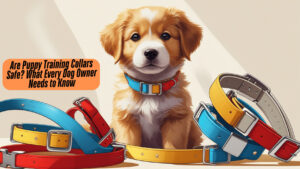The right training collar is crucial for small breed puppies. Picking the correct one can make training easier and more effective. Small breeds have unique needs that require special attention when it comes to collars. Understanding these needs will help you avoid common training collar mistakes.
The Unique Needs of Small Breed Puppies
Small breed puppies are often more sensitive than larger dogs. A collar that is too heavy or uncomfortable can lead to resistance during training. Understanding your puppy’s temperament and size will guide you in making a better choice.
- Always consider the puppy’s age and size.
- Look for lighter materials that won’t overwhelm them.
- Think about the comfort level to avoid distractions during training.
Avoiding Common Training Collar Mistakes
Many owners mistakenly choose collars that are not designed for small dogs. Collars intended for larger breeds can fit poorly or be too heavy.
- Avoid leashes that are too long or heavy.
- Stay clear of shock collars, which can harm your puppy emotionally and physically.
- Ensure the collar doesn’t restrict movement or cause discomfort.
Setting Your Puppy Up for Success
When you select the right collar, you’re setting your puppy up for success. A comfortable collar supports positive behavior during training. Keep these factors in mind:
- Choose a collar that fits comfortably.
- Consider your puppy’s behavior to select the best style.
- Make adjustments based on your puppy’s growth and development.

Understanding Different Types of Training Collars
Several types of collars cater to small breeds, each with its own advantages and disadvantages. Here’s a look at some popular types:
Harness vs. Collar: Key Differences and Benefits
- Harnesses distribute pressure across your puppy’s body, which can minimize strain on their neck.
- Collars are simpler for quick control but should fit well to avoid choking risks.
Head Halters: Effectiveness and Potential Drawbacks
Head halters can offer good control but may not be ideal for all small breeds. While effective in reducing pulling, they might take time for your puppy to adjust.
Gentle Leader Collars: How They Work and When to Use Them
Gentle Leader collars are designed to gently guide your puppy rather than restrain them. They can be effective for training, particularly for pullers, but may require gradual introduction for comfort.
Size and Fit: Crucial Considerations for Small Breeds
Proper sizing is essential when selecting a collar for small breed puppies.
Measuring Your Puppy for the Perfect Fit
To find the perfect fit:
- Measure the neck circumference with a soft tape measure.
- Ensure there is space for two fingers between the collar and your puppy’s neck.
Avoiding Collars That Are Too Tight or Too Loose
A collar that’s too tight can cause pain and injury. A loose collar can slip off. Regularly check the fit as your puppy grows.
The Impact of Improper Fit on Your Puppy’s Comfort and Training
Misfitting collars can lead to discomfort and distraction, hindering training progress. Always prioritize comfort to promote positive learning experiences.
Material and Durability: Finding a Collar Built to Last
Selecting the right material is key to ensuring your collar lasts long enough to support training efforts.
Nylon vs. Leather: Pros and Cons of Popular Materials
- Nylon collars are lightweight, adjustable, and come in various colors and designs.
- Leather collars are more durable but can be heavier and may not suit all small breeds.
Choosing Durable Materials for Active Puppies
Active puppies can wear out collars quickly. Look for strong stitching and durable buckles to ensure longevity.
Assessing the Collar’s Overall Construction and Stitching
Well-constructed collars usually have double stitching. Examine these features to ensure safety and comfort.
Features to Consider: Safety and Comfort
Look for specific features when choosing a collar for your puppy:
Buckle vs. Quick-Release Clasps: Which Is Best for Your Puppy?
Quick-release clasps are often more convenient, especially for small breeds. They allow for fast adjustments and removal, which can help in emergencies.
Reflective Materials for Enhanced Visibility
Reflective elements can improve visibility during evening walks, enhancing safety for both you and your puppy.
Comfort Padding and Features to Prevent Chafing
Collars with added padding can prevent chafing, ensuring comfort during wear.
Training Your Puppy with the Right Collar: Positive Reinforcement Techniques
Successful training involves using the collar in conjunction with positive reinforcement methods.
Using Positive Reinforcement Alongside Your Chosen Collar
Rewarding good behavior encourages better obedience. Combine treats and praise with collar training to build a strong bond.
Common Mistakes to Avoid During Training Sessions
Mistakes can derail training progress. Avoid yelling or using harsh methods. Focus on positivity and patience for better results.
Seeking Professional Guidance from a Certified Dog Trainer
If struggling, consider seeking help from a professional trainer. They can provide personalized guidance for your specific situation.
Conclusion: A Recap of Key Considerations
Choosing the right training collar for small breed puppies involves multiple factors. Remember:
- Different types of collars cater to various training needs.
- Proper fit is crucial for both safety and comfort.
- The collar you choose impacts long-term behavior and bonding.
Investing time and effort in the right collar will yield positive results in your puppy’s training journey. Your small breed puppy deserves the best to ensure successful training and a loving relationship.




